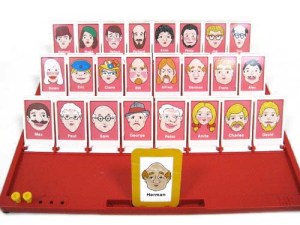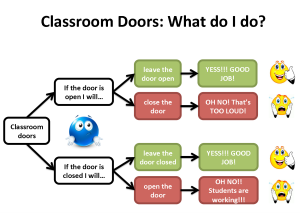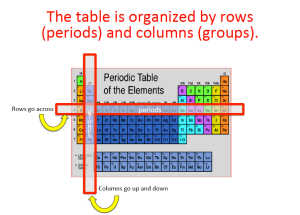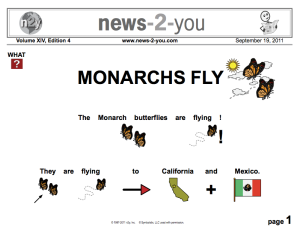 Remember this game!? it has been around since 1979 and is still going strong! For those of you who aren’t familiar, here is the gist.
Remember this game!? it has been around since 1979 and is still going strong! For those of you who aren’t familiar, here is the gist.
Guess Who is a 2 player game, where each player starts the game with a board that includes cartoon images of 24 people and their first names with all the images standing up. Each player selects a card from a separate pile of cards containing the same 24 images. Players alternate asking various yes or no questions to eliminate characters, such as “Does this person wear glasses?”
I LOVED THIS GAME!!!
The good news is that is has evolved from 24 white people with chubby cheeks and towards little more of a diverse crowd. This game is a great game for developing skills like asking questions, but also visual referencing and comprehension. It’s manipulative nature and little words also makes it vary accessible to a lot of the kids that we work with.
Because of this, we incorporated this game as an activity in our “ALL ABOUT ME” unit, which we implemented at the beginning of each year…with one little modification.
 Who says we need to ask questions about chubby white people, when we can ask questions about EACH OTHER.
Who says we need to ask questions about chubby white people, when we can ask questions about EACH OTHER.
We changed every person on the cards, into a person in our school. Our Guess Who game went from a generic boring irrelevant game, and into a situated, authentic and fun way to learn more about each other, while still developing some of the skills mentioned above.
The student love seeing pictures of themselves on the playing cards. We just took pictures and taped them directly to the cards.
For students who need communication support, with a visual board developed specifically with the students features in mind.
 We included both students, educational assistants, teachers and administrators on the board, with the intention that this game would also help students with conversation starters when interacting with people in real life.
We included both students, educational assistants, teachers and administrators on the board, with the intention that this game would also help students with conversation starters when interacting with people in real life.
An easy activity, that the students LOVED! AND you can often find these games for cheap at second hand shops or craigslist.

Goals: Asking questions, turn-taking, visual referencing, processing/analyzing, process of elimination, learning names, matching, word work, reading
Unit: All About Me!
Activity: Guess Who?
Other All About Me! Activities:
 A couple of years ago I worked with a grade 2 student named Joshua! Together we constructed a social story to manage the self regulation of his thinking to help him focus on learning. The example was described in Butler, Perry & Schnellert’s new book Developing Self Regulating Learners and talks about the process we went through to support Joshua, his educational assistant and his teacher.
A couple of years ago I worked with a grade 2 student named Joshua! Together we constructed a social story to manage the self regulation of his thinking to help him focus on learning. The example was described in Butler, Perry & Schnellert’s new book Developing Self Regulating Learners and talks about the process we went through to support Joshua, his educational assistant and his teacher. Remember this game!? it has been around since 1979 and is still going strong! For those of you who aren’t familiar, here is the gist.
Remember this game!? it has been around since 1979 and is still going strong! For those of you who aren’t familiar, here is the gist.
 Who says we need to ask questions about chubby white people, when we can ask questions about EACH OTHER.
Who says we need to ask questions about chubby white people, when we can ask questions about EACH OTHER.










 We learn about many different people in our schooling lives. An easy way to make this accessible for students with disabilities
We learn about many different people in our schooling lives. An easy way to make this accessible for students with disabilities 
 This social studies 10 class was learning about supply and demand, for Sharon, however, her goal was to understand and differentiate the concepts of buy, sell, craft and goods. This also happened to be the the first lesson for everyone in the class. A great strategy for teachers who want to create accessibility and build background knowledge at the same time. Spending time on this foundational, otherwise assumed, background information, proves helpful to many students, not just those with additional learning needs. Although Sharon stayed with this goal for the unit, the rest of the class built on from there. A much easier strategy than teaching and then trying to simplify and retrofit curriculum after its been taught, or trying to modify a lesson on the fly. This book was used to support Sharon learn the new information.
This social studies 10 class was learning about supply and demand, for Sharon, however, her goal was to understand and differentiate the concepts of buy, sell, craft and goods. This also happened to be the the first lesson for everyone in the class. A great strategy for teachers who want to create accessibility and build background knowledge at the same time. Spending time on this foundational, otherwise assumed, background information, proves helpful to many students, not just those with additional learning needs. Although Sharon stayed with this goal for the unit, the rest of the class built on from there. A much easier strategy than teaching and then trying to simplify and retrofit curriculum after its been taught, or trying to modify a lesson on the fly. This book was used to support Sharon learn the new information.

 This book is about the big idea of organization, and how it is applied to the scientific elements. The book is written at two levels, at the conventional level for reading out loud to James, and at the transitional level for James to read independently. To differentiate the difference, James knew that his words were red.
This book is about the big idea of organization, and how it is applied to the scientific elements. The book is written at two levels, at the conventional level for reading out loud to James, and at the transitional level for James to read independently. To differentiate the difference, James knew that his words were red.


